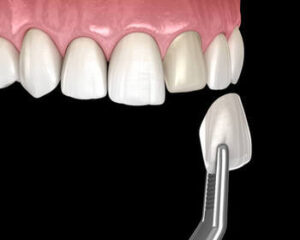When it comes to attaining a flawless smile, two popular options stand out: veneers and lumineers. Both are cosmetic dentistry treatments that can dramatically transform your smile, but how do they differ? More importantly, why might veneers be the superior choice? Let’s delve into the world of dental veneers, highlighting the key differences, advantages, and what you need to know to make an informed decision.
Veneers vs Lumineers: What’s the Difference?
The terms “veneers” and “lumineers” are often used interchangeably, but they aren’t the same. Both are designed to enhance the appearance of your front teeth, but they vary in several crucial aspects.
- Veneers: These are ultra-thin shells made from porcelain or composite resin that conceal the front surface of your teeth. They’re custom-made in a dental laboratory to fit your teeth perfectly, creating a natural-looking smile.
- Lumineers: Lumineers are a specific ultra-thin veneers made from porcelain. They’re considered “minimal prep” veneers, meaning they require little enamel removal. Lumineers tend to be thinner than traditional porcelain veneers.
Key Differences:
- Traditional veneers require more tooth preparation, while lumineers are often applied with minimal tooth structure removal.
- Lumineers are generally more translucent, making them less effective at masking severe discolouration or cosmetic issues.
The Process: Veneers vs Lumineers – What to Expect
Both veneers and lumineers require a multi-step process, but there are some notable differences.
The Veneers Process:
- Consultation: Your dentist will assess your dental concerns and discuss your goals for the treatment outcome.
- Tooth Preparation: A thin layer of enamel removal is required to create space for the veneers. This process ensures that the veneers fit seamlessly on your natural tooth surface.
- Temporary Veneers: Temporary veneers may be cemented while waiting for the permanent veneers to be custom-made in a dental laboratory.
- Final Placement: At the second appointment, the dentist will attach the permanent veneers to your teeth.
The Lumineers Process:
- Consultation: Similar to veneers, your cosmetic dentist evaluates your needs and goals.
- Minimal Preparation: Lumineers require little enamel removal, making them less invasive.
- Final Placement: Lumineers are custom-made and permanently bonded to the teeth.
Crucial Differences: The tooth preparation process is more intensive for veneers, while lumineers require little to no alteration of the natural tooth structure.
Why Veneers Outshine Lumineers: The Clear Advantages
Now, let’s break down why veneers are often considered the superior choice:
More Natural-Looking Results
Traditional porcelain veneers provide a more natural appearance because they resemble the light-reflecting properties of natural teeth. Lumineers can sometimes appear slightly bulky or less realistic, especially if no enamel removal was performed.
Better for Addressing Severe Dental Issues
If you have crooked teeth, broken teeth, severe discolouration, or cosmetic problems, veneers are more effective in covering these imperfections. Their thickness allows them to conceal a broader range of dental issues compared to the thinner lumineers.
Longer-Lasting Solution
Porcelain veneers are more durable and last longer than lumineers, with a lifespan of 10-15 years or even longer with proper care. Lumineers, while also durable, may need replacement sooner due to their ultra-thin design.
Greater Stain Resistance
Veneers, especially porcelain veneers, are highly stain-resistant, making them ideal for those who want a smile that stays bright over time.
Tooth Preparation: Why Veneers Require More Preparation
Traditional veneers require the removal of a thin layer of tooth enamel to create a smooth and even surface for bonding. While this process might sound intimidating, it’s essential for achieving a flawless finish. It also ensures that the veneers blend seamlessly with your existing teeth without adding bulk.
Lumineers, on the other hand, require minimal enamel removal, making the procedure less invasive. However, this can sometimes result in a slightly thicker appearance on the front of your teeth, which may not look as natural.
Veneers require more tooth structure removal, but this means they fit better, feel more natural, and are less likely to add bulk to your smile. Lumineers are an excellent option for those who want a less invasive treatment, but the lack of tooth preparation may result in a less seamless fit.
Lumineers Cost vs Veneers Cost: Is the Investment Worth It?
When comparing the final cost, it’s essential to consider that veneers typically cost more upfront due to the extensive preparation and customisation involved. The lumineers cost might be lower initially, but their shorter lifespan and potential need for earlier replacement can make them more expensive in the long run.
Common Dental Issues Treated by Veneers and Lumineers
Both lumineers and veneers are effective in treating various dental issues, including:
- Teeth discolouration
- Cracked or broken teeth
- Teeth minor misalignment
- Stained teeth
- Crooked teeth
However, veneers excel in treating more severe cosmetic dental problems due to their thicker and more robust design.
Porcelain or Composite Resin: Which Is Better for Veneers?

- Porcelain Veneers: Known for their durability, natural appearance, and stain resistance. They are the preferred choice for those seeking a long-lasting solution.
- Composite Veneers: Made from composite resin, these veneers are more affordable but tend to be less durable and stain-resistant than porcelain veneers.
Veneers and Lumineers: Which One Is Right for You?
Deciding between veneers and lumineers depends on your individual needs and goals. If you’re looking for a more conservative option with minimal tooth structure removal, lumineers might be suitable. However, if you want a more natural-looking, long-lasting, and effective solution for severe dental issues, veneers are the better choice.
Frequently Asked Questions About Veneers and Lumineers
Q: Are veneers or lumineers more painful?
A: With veneers, you may require local anaesthesia during the preparation process due to enamel removal. Lumineers typically don’t require anaesthesia, as minimal prep is involved.
Q: Can dental insurance cover veneers or lumineers?
A: Both treatments are considered cosmetic and are usually not covered by dental insurance.
Q: How long do veneers and lumineers last?
A: Porcelain veneers can last 10-15 years or longer with proper care, while lumineers typically last around 8-10 years.
Q: Can veneers or lumineers fix gaps between teeth?
A: Yes, both veneers and lumineers can effectively close small gaps between teeth, creating a more uniform and symmetrical smile. However, veneers are generally more effective at addressing larger gaps due to their thickness and better coverage.
Q: How do veneers and lumineers impact gum health?
A: When placed correctly by a skilled dentist, both veneers and lumineers should not negatively affect your gum health. Good oral hygiene habits, such as brushing and flossing, are essential to maintaining healthy gums with either option. However, because lumineers are thinner, there’s less risk of irritation to the gum line due to minimal preparation.
Q: Can veneers or lumineers correct severely crooked teeth?
A: While veneers and lumineers can help enhance the appearance of slightly crooked teeth, they are not a replacement for orthodontic treatments like braces or clear aligners. If your teeth have severe misalignment, your dentist may recommend straightening options before considering veneers or lumineers.
Q: How do I take care of my veneers or lumineers after placement?
A: Proper care involves brushing twice a day with non-abrasive toothpaste, flossing daily, and avoiding habits like biting nails or chewing on hard items. Regular dental check-ups are also important to guarantee the longevity of both veneers and lumineers.
Q: Are there any dietary restrictions with veneers or lumineers?
A: While both veneers and lumineers are durable, it’s wise to avoid biting into very hard foods (like ice or hard candy) to prevent chipping. Also, limiting staining foods and beverages such as coffee, red wine, and tea is recommended to maintain their pristine appearance, especially if you have composite veneers.
Q: Can veneers or lumineers be whitened?
A: No, veneers and lumineers cannot be whitened with traditional teeth whitening treatments. If they become discoloured or stained over time, you may need to replace them to restore their original appearance.
Q: Can lumineers or veneers fix chipped teeth?
A: Yes, both lumineers and veneers can effectively cover chipped teeth. However, due to their thickness, traditional veneers may provide better protection and durability for more significant chips.
Q: Will I need temporary veneers or lumineers before my final set is placed?
A: For veneers, temporary veneers may be applied while your custom veneers are being made. Lumineers, on the other hand, usually don’t require temporary placement since there is little tooth preparation involved.
Q: Can veneers or lumineers feel uncomfortable or foreign in the mouth?
A: Initially, it may take a few days to get used to the feel of veneers or lumineers, especially if enamel was removed during the preparation. However, once you adjust, they should feel natural and comfortable. If discomfort persists, consult your dentist for adjustments.
Q: Can I combine lumineers and veneers on different teeth?
A: While it’s possible to have both lumineers and veneers, it’s generally recommended to stick to one type for a uniform look. Using both may result in slight variations in thickness or appearance.
Final Verdict: Lumineers vs Veneers – The Superior Choice for a Flawless Smile

If you’re considering dental veneers, contact Dental 266 at (02) 9051 0600 to explore your options. With the right choice, you’ll be on your way to achieving the stunning, confident smile you’ve always dreamed of!
References:
WebMD. (n.d.). Dental Veneers: Pros and Cons, Types, Procedures, and Costs. https://www.webmd.com/oral-health/veneers
Collins, S. (2019, November 20). Veneers vs. Lumineers: What’s the Difference?. Healthline. https://www.healthline.com/health/veneers-vs-lumineers
Colgate. (n.d.). What Causes Crooked Teeth? https://www.colgate.com/en-us/oral-health/adult-orthodontics/what-causes-crooked-teeth
4. National Institute of Dental and Craniofacial Research (NIDCR). (n.d.). Oral Hygiene. https://www.nidcr.nih.gov/health-info/oral-hygiene







